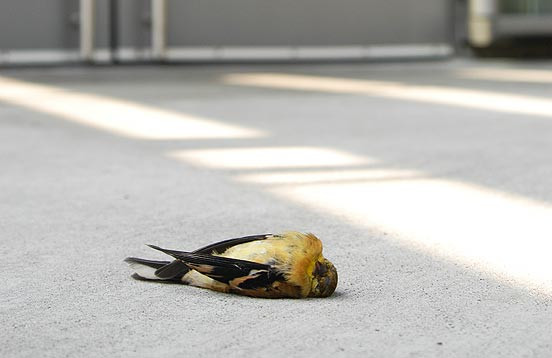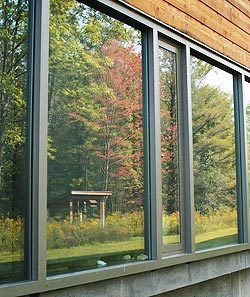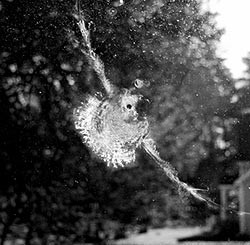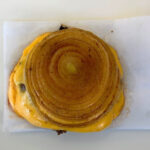Birds flying into windows is a heartbreaking and surprisingly common problem. For birds, glass windows are often invisible barriers, reflecting inviting scenes of foliage or sky that lead to fatal collisions. In fact, window strikes are a major threat to bird populations, with studies estimating up to one billion birds die annually in the U.S. alone due to this issue. These collisions aren’t just tragic for individual birds; they represent a significant ecological concern.
Fortunately, protecting birds from window strikes is achievable with simple and effective solutions for your home. Experts like Christine Sheppard, who directs the Bird Collisions Program at the American Bird Conservancy, emphasize that taking action can greatly reduce the danger your windows pose. Numerous resources, including the American Bird Conservancy and the Fatal Light Awareness Program (FLAP), offer comprehensive guidance on preventing these collisions.
What happens when birds hit windows? The impact is often deadly. Even if a bird appears to fly away after striking a window, it may succumb to internal injuries, bleeding, or brain trauma later. Daniel Klem, a researcher who has studied bird-window collisions extensively, poignantly described glass as “an indiscriminate killer.” This highlights the urgency and importance of making our windows bird-safe.
Understanding Why Birds Collide With Windows
 American Goldfinch killed by window strike
American Goldfinch killed by window strike
Bird-window collisions can be broadly categorized into two types: daytime and nighttime collisions, each with distinct causes.
During the day, birds primarily collide with windows because of reflections. Windows mirror the surrounding environment, creating illusions of open flyways through vegetation or clear paths to the sky. Birds perceive these reflections as real, leading them to fly directly towards the glass. Furthermore, birds may see through windows to indoor plants or vegetation visible on the other side, further contributing to the illusion of a safe passage.
At night, the danger shifts for nocturnal migrating birds, which include the majority of songbirds. These birds are often disoriented by artificial lights. Urban and suburban lights can draw migrating birds off their natural course, especially in foggy or low-ceiling conditions. Disoriented birds can become trapped in brightly lit areas, increasing the risk of collisions with buildings and windows, and even other birds. The BirdCast project and FLAP provide valuable insights into the impact of light pollution on bird migration and advocate for “lights out” initiatives.
Another less common reason for window strikes is territorial behavior. Especially during spring breeding season, birds might see their own reflection in a window and perceive it as a rival. This can lead to aggressive attacks on the reflection. While less dangerous for the bird compared to collision strikes, it can still be stressful and create a mess for homeowners. Fortunately, many solutions designed to prevent collision strikes also address this territorial reflection issue.
Effective Ways to Safeguard Your Windows for Birds
 Reflection of foliage in window – hazard to birds
Reflection of foliage in window – hazard to birds
The first step in making your home bird-friendly is to identify the most hazardous windows. Large picture windows, corner windows that create see-through illusions, and windows near bird feeders are often high-risk areas. To assess your windows from a bird’s perspective, go outside and observe them. If you see reflections of vegetation, trees, or sky, or if you can see through the window to the other side of your house or garden, these windows are likely posing a threat. Contrary to older advice, the distance of bird feeders from windows is less critical than making the windows themselves safe. If you have feeders, ensuring nearby windows are bird-friendly becomes even more important.
Practical Treatments for Existing Windows
For existing windows, various treatments can effectively deter birds. The key principle is to make the window visible to birds by disrupting the reflection or creating a visual barrier. For small birds, markings should ideally be spaced no more than 2 inches apart. For larger, more visible deterrents like Acopian BirdSavers, a spacing of 4 inches can be effective. Crucially, all treatments must be applied to the outside surface of the window to break up the reflection.
Here are several effective methods:
-
Tempera Paint or Soap: A simple and cost-effective solution is to use tempera paint or soap to mark the exterior of your windows. You can create a 2×2 inch grid pattern, or even get creative with patterns and artwork. These markings are temporary but long-lasting enough for seasonal use.
-
Window Decals and Stickers: Apply decals, stickers, sun catchers, mylar strips, or even masking tape to the outside of the window. Spacing is critical; ensure dense coverage with narrow gaps. Hawk silhouettes alone are not effective deterrents. A few stickers on a large window are insufficient – aim to cover most of the glass surface.
-
Dot Patterns and Tape Products: Specialized tape products designed for bird safety, like those from Feather Friendly, offer pre-spaced dot patterns that are easy to apply and highly effective. These provide a more durable and less visually obtrusive solution than paint or general stickers.
-
Acopian BirdSavers (Zen Curtains): These consist of closely spaced cords hanging vertically in front of windows. Often called “zen curtains,” they are highly effective, aesthetically pleasing to some, and easier to install than some other methods. The Cornell Lab of Ornithology headquarters utilizes Acopian BirdSavers to protect their windows, highlighting their effectiveness. You can purchase pre-made BirdSavers or even create your own DIY versions.
-
Screens: Installing mosquito screens over your windows provides excellent bird protection, provided they are mounted on the outside and cover the entire window surface.
-
Netting: Covering the exterior glass with netting creates a physical barrier. The netting should be taut and positioned at least 3 inches away from the glass to prevent birds from hitting the window behind it. Small mesh netting (around 5/8″ or 1.6 cm) is ideal to prevent entanglement. Netting can be attached to frames for easier installation and removal.
-
One-Way Transparent Film: Products like Collidescape are films applied to windows that allow people inside to see out, but make the window appear opaque from the outside to birds. These films can also reduce sunlight penetration, potentially lowering cooling costs.
Planning for Bird-Safe Windows in New Homes and Remodels
For new construction or window replacements, consider incorporating bird-friendly design elements from the outset:
-
External Shutters: Install and utilize external shutters, closing them when rooms are unoccupied or when you don’t need natural light or views. Shutters offer the added benefit of energy savings.
-
External Sun Shades and Awnings: These architectural elements block sunlight reflections from windows. Motorized, remote-controlled options provide convenience.
-
Windows with External Screens: Choose windows designed with screens covering the entire outer glass surface during installation.
-
Interior Vertical Blinds: Using interior vertical blinds and keeping the slats partially closed can help break up reflections.
-
Minimize Visual Paths to Sky and Greenery: Avoid creating direct visual pathways through your home to outdoor greenery or sky. For example, bright windows directly opposite a large picture window can create a dangerous illusion of a continuous open space. Closing interior doors or using shades can disrupt these visual paths.
Lights Out: Reducing Nighttime Hazards
“Lights Out” initiatives are gaining momentum in cities across the U.S., including major migratory flyways. These programs encourage turning off non-essential lights in buildings at night, particularly during bird migration seasons. Excessive nighttime lighting in urban environments disorients migrating birds, leading to exhaustion and increased window collision risks. Switching off unnecessary lights and using downward-facing outdoor lighting are simple yet impactful steps to reduce light pollution and protect migrating birds. Even with community-level efforts, individual homeowners should still implement window safety measures, as residential windows also contribute to bird collisions.
How to Help a Bird Injured in a Window Collision
 imprint of dove on plate glass window
imprint of dove on plate glass window
If you find a bird that has collided with your window, immediate action can significantly improve its chances of survival. Window collision victims often suffer internal injuries that are not immediately apparent. Without help, they are vulnerable to predators and further harm. Here’s how to assist an injured bird:
-
Capture and Contain: Approach the bird gently from behind and use both hands to cup it. Be prepared for fluttering or vocalizations. Handle small birds delicately, ensuring a secure but gentle grip without squeezing.
-
Prepare a Container: Find a safe container, such as an unwaxed paper bag or a small cardboard box lined with tissue paper or paper towels (for grip). Place the bird inside and close the container securely.
-
Provide a Safe Environment: Keep the contained bird in a dark, quiet, warm, and safe location, away from children and pets.
-
Do Not Handle, Feed, or Water: Avoid unnecessary handling, feeding, or giving water to the bird. Wild birds perceive humans as threats, and minimizing stress is crucial.
-
Contact a Wildlife Rehabilitator: Locate a licensed wildlife rehabilitator near you using online directories (like the Humane Society’s resource). Contact them for guidance and instructions. They can provide specialized care. If you cannot transport the bird, inform the rehab facility, as they may have alternative solutions.
-
Release (If Instructed): Only release the bird if the rehabilitator advises you to do so. Take it to a wooded area or suitable habitat away from buildings. Before releasing, observe its flight ability briefly. If the bird seems unable to fly properly, recapture it and re-contact the wildlife rehabilitator for further assistance.
By understanding why birds fly into windows and implementing these preventative measures, you can make a significant difference in protecting birds in your area. Taking action to make your windows bird-safe is a simple yet powerful way to contribute to bird conservation and enjoy the beauty of birds around your home without causing them harm.
